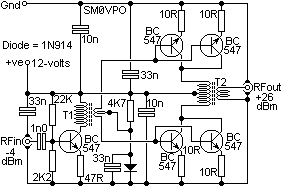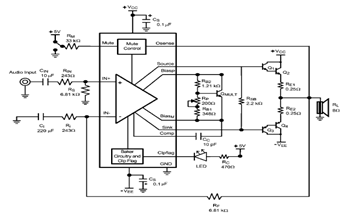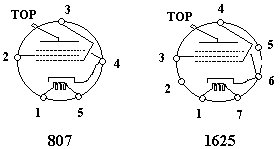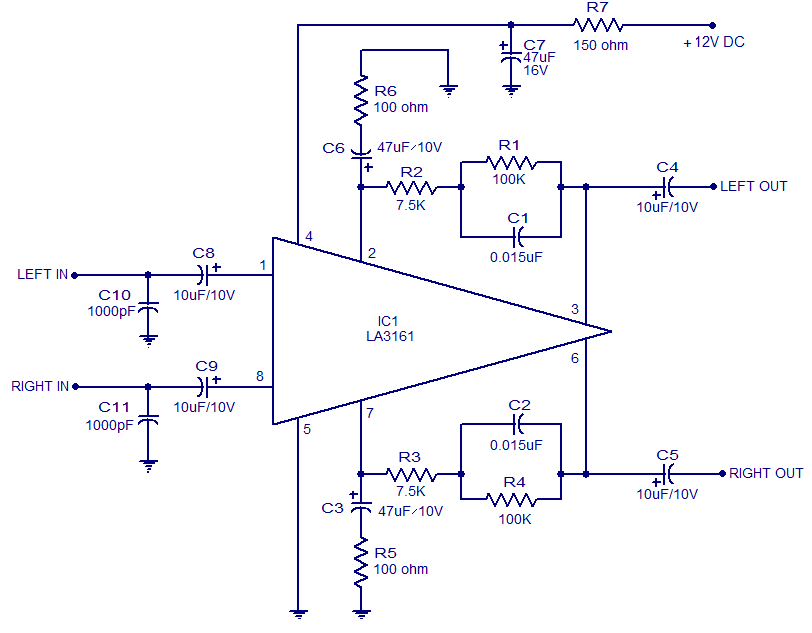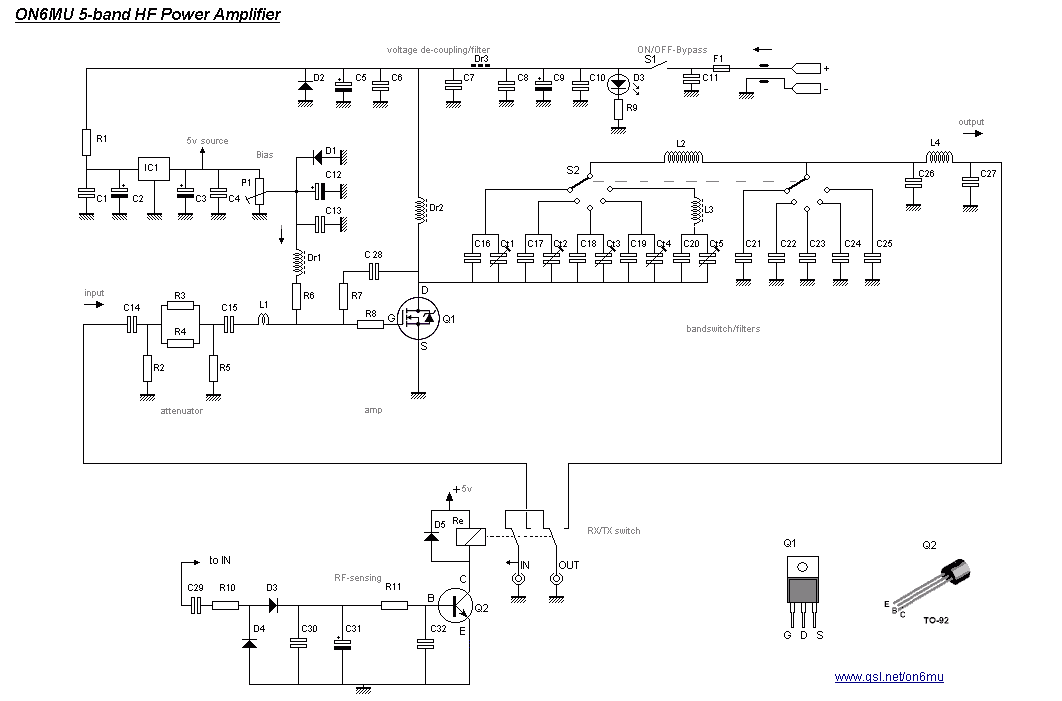
450 watts / 3.5-30 MHz Linear amplifier
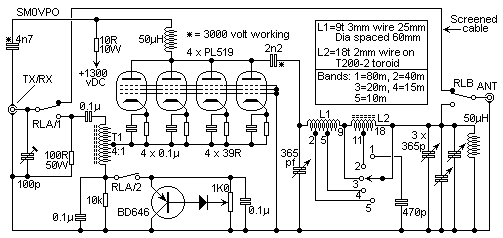
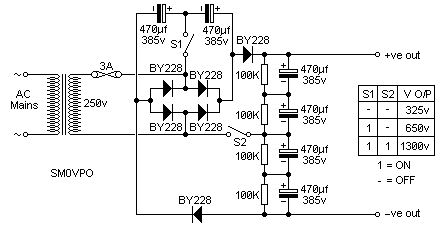
This is the circuit of a 500 watt linear amplifier, based upon a design by Frits Geerligs, PA0FRI, who has his own homepage at http://home.planet.nl/~fhvgeerligs. The circuit uses four PL519 TV line output valves in a very simple circuit that will deliver over 450 watts at 3.5 MHz (350 watts at 30 MHz). PL519 (40KG6A) is a more robust replacement for the earlier PL509 (40KG6) tube. Both valves will work well in this circuit. The input drive power is about 50 - 100 watts so it is compatible with most amateur radio HF transmitters. Not shown in the circuit is the cooling fan that is required to force air around the valves to cool them. In operation the 1K0 pot is adjusted to set the total valve anode current to around 50mA to 70 mA.
T1 is a 4:1 balun wound on a 5cm ferrite rod. 9 + 9 turns. Connect the end of the first winding to the start of the second to form the center tap. L1 is 9 turns of 3mm Dia wire, wound on a 25mm Dia, 60mm long former. L2 is 18 turns on a toroidal former. Use two lengths of 2mm Dia wire, one with 11 turns and the other with 7 turns. The 50 watt 100 ohm resistor recommended by PA0FRI is formed by two 50 ohm 25 watt non-inductive TO-220 resistors in series, bolted beside the fan. I use 100 x 10K carbon resistors arranged 10 x 10 between two pieces of 0.1" matrix wiring board (veroboard). My method is cheaper and avoids the need to mount input circuitry above chassis. All inputs are kept below the chassis whilst the valve anode terminals and output circuitry is kept below the chassis. The 100pf trimmer capacitor is adjusted for best VSWR from the driving transmitter at 29 MHz.
All four valve heaters (40 volts each) may be wired in series and connected to the 220 volt mains via a 6uf 250vAC capacitor for 50 Hz (5uf for 60 Hz). I personally favour the use of a 40 volt transformer winding, on a home-made transformer, to run all the valves heaters (in parallel) as well as the 40 volt fan. This places less strain on the cathode/heater insulation of old tubes that may have been kicked around in junk boxes for years. Winding transformers can be quite involved and I am writing an article for this on another page. But, here is the basic method I used. Measure the available winding area and fill 16% of it with 0.7mm enameled wire, counting the turns. Add an identical winding of the same number of turns. Add a third winding using the same gauge but only 36% of the number of turns. Add a fourth winding using ten times the number of turns and using 0.2mm enamelled wire. All windings must be well insulated from each other and the fourth winding must be wound in about five sections, each insulated from the other. I use waxed paper for insulation. Do NOT use adhesive tape, masking tape or sticky backed insulating tape.
Connect the two primaries in series for 240 volt operation or in parallel for 120 volt operation. Check, with a resistance meter, that the transformer windings are isolated from each other and the case. When electrically testing the transformer, connect it to the mains without a load; the mains power in series with a mains 100 watt light-bulb. Check that the two secondaries are about 40 volts and 1100 volts. If the lightbulb lights up then you have got one of the primaries the wrong way round, or there is a fault in transformer construction. PA0FRI suggests a power supply circuit which is switchable and delivers 325 volts, 650 volts or 1300 volts to the amplifier. The circuit is very clever, and shown below for your interest.
The described circuit is a robust and efficient 500-watt linear amplifier designed primarily for amateur radio applications. Utilizing four PL519 vacuum tubes, the amplifier can achieve significant output power, making it suitable for various HF bands, particularly at 3.5 MHz and 30 MHz. The choice of PL519 tubes offers enhanced durability compared to their predecessors, ensuring reliability in demanding operational conditions. The amplifier's input requirements are compatible with standard amateur radio transmitters, allowing for seamless integration into existing setups.
The balun transformer (T1) plays a crucial role in impedance matching, ensuring that the amplifier can efficiently transfer power to the antenna system. The use of a ferrite rod for the balun construction aids in minimizing losses and improving overall performance. The inductors (L1 and L2) are specifically designed to maintain the desired frequency response and stability of the amplifier, with careful attention to the winding specifications to optimize inductance.
Thermal management is a vital aspect of the design, with provisions for a cooling fan to prevent overheating of the vacuum tubes during operation. The adjustment of the anode current via the 1K0 potentiometer allows for fine-tuning of the amplifier's performance, ensuring optimal operation within specified parameters.
The power supply section is designed to accommodate various input voltages, offering flexibility for different operational environments. The transformer winding strategy described enhances the efficiency and reliability of the heater supply for the vacuum tubes, which is critical for maintaining performance and longevity. The careful insulation and construction techniques outlined for the transformer ensure safety and functionality, minimizing the risk of electrical faults.
Overall, this linear amplifier circuit exemplifies a well-thought-out design that balances performance, efficiency, and reliability, making it a valuable asset for amateur radio enthusiasts.This is the circuit of a 500 watt linear amplifier, based upon a design by Frits Geerligs, PA0FRI, who has his own homepage at http://home.planet.nl/~fhvgeerligs. The circuit uses four PL519 TV line output valves in a very simple circuit that will deliver over 450 watts at 3.5 MHz (350 watts at 30 MHz).
PL519 (40KG6A) is a more robust replacement for the earlier PL509 (40KG6) tube. Both valves will work well in this circuit. The input drive power is about 50 - 100 watts so it is compatible with most amateur radio HF transmitters. Not shown in the circuit is the cooling fan that is required to force air around the valves to cool them.
In operation the 1K0 pot is adjusted to set the total valve anode current to around 50mA to 70 mA. T1 is a 4:1 balun wound on a 5cm ferrite rod. 9 + 9 turns. Connect the end of the first winding to the start of the second to form the center tap. L1 is 9 turns of 3mm Dia wire, wound on a 25mm Dia, 60mm long former. L2 is 18 turns on a toroidal former. Use two length of 2mm Dia wire, one with 11 turns and the other with 7 turns. The 50 watt 100 ohm resistor recomended by PA0FRI is formed by two 50 ohm 25 watt non-inductive TO-220 resistors in series, bolted beside the fan. I use 100 x 10K carbon resistors aranged 10 x 10 between two pieces of 0.1" matrix wiring board (veroboard).
My method is cheaper and avoids the need to mount input circuitry above chassis. All inputs are kept below the chassis whilst the valve anode terminals and output circuitry is kept below the chassis. The 100pf trimmer capacitor is adjusted for best VSWR from the driving transmitter at 29 MHz. All four valve heaters (40 volts each) may be wired in series and connected to the 220 volt mains via a 6uf 250vAC capacitor for 50 Hz (5uf for 60 Hz).
I personally favour the use of a 40 volt transformer winding, on a home-made transformer, to run all the valves heaters (in parallel) as well as the 40 volt fan. This places less strain on the cathode/heater insulation of old tubes that may have been kicked around in junk boxes for years.
Winding transformers can be quite involved and I am writing an article for this on another page. But, here is the basic method I used. Measure the available winding area and fill 16% of it with 0.7mm enameled wire, counting the turns. Add an identical winding of the same number of turns. Add a third winding using the same guage but only 36% of the number of turns. Add a fourth winding using ten times the number of turns and using 0.2mm enamelled wire. All windings must be well insulated from each other and the fourth winding must be wound in about five sections, each insulated from the other. I use waxed paper for insulation. Do NOT use adhesive tape, masking tape or sticky backed insulating tape. Connect the two primaries in series for 240 volt operation or in parallel for 120 volt operation. Check, with a resistance meter, that the transformer windings are isolated from each other and the case.
When electrically testing the transformer, connect it to the mains without a load; the mains power in series with a mains 100 watt light-bulb. Check that the two secondaries are about 40 volts and 1100 volts. If the lightbulb lights up then you have got one of the primaries the wrong way round, or there is a fault in transformer construction.
PA0FRI sugests a power supply circuit which is switcheable and delivers 325 volts, 650 volts or 1300 volts to the amplifier. The circuit is very clever, and shown below for your interest. 🔗 External reference
T1 is a 4:1 balun wound on a 5cm ferrite rod. 9 + 9 turns. Connect the end of the first winding to the start of the second to form the center tap. L1 is 9 turns of 3mm Dia wire, wound on a 25mm Dia, 60mm long former. L2 is 18 turns on a toroidal former. Use two lengths of 2mm Dia wire, one with 11 turns and the other with 7 turns. The 50 watt 100 ohm resistor recommended by PA0FRI is formed by two 50 ohm 25 watt non-inductive TO-220 resistors in series, bolted beside the fan. I use 100 x 10K carbon resistors arranged 10 x 10 between two pieces of 0.1" matrix wiring board (veroboard). My method is cheaper and avoids the need to mount input circuitry above chassis. All inputs are kept below the chassis whilst the valve anode terminals and output circuitry is kept below the chassis. The 100pf trimmer capacitor is adjusted for best VSWR from the driving transmitter at 29 MHz.
All four valve heaters (40 volts each) may be wired in series and connected to the 220 volt mains via a 6uf 250vAC capacitor for 50 Hz (5uf for 60 Hz). I personally favour the use of a 40 volt transformer winding, on a home-made transformer, to run all the valves heaters (in parallel) as well as the 40 volt fan. This places less strain on the cathode/heater insulation of old tubes that may have been kicked around in junk boxes for years. Winding transformers can be quite involved and I am writing an article for this on another page. But, here is the basic method I used. Measure the available winding area and fill 16% of it with 0.7mm enameled wire, counting the turns. Add an identical winding of the same number of turns. Add a third winding using the same gauge but only 36% of the number of turns. Add a fourth winding using ten times the number of turns and using 0.2mm enamelled wire. All windings must be well insulated from each other and the fourth winding must be wound in about five sections, each insulated from the other. I use waxed paper for insulation. Do NOT use adhesive tape, masking tape or sticky backed insulating tape.
Connect the two primaries in series for 240 volt operation or in parallel for 120 volt operation. Check, with a resistance meter, that the transformer windings are isolated from each other and the case. When electrically testing the transformer, connect it to the mains without a load; the mains power in series with a mains 100 watt light-bulb. Check that the two secondaries are about 40 volts and 1100 volts. If the lightbulb lights up then you have got one of the primaries the wrong way round, or there is a fault in transformer construction. PA0FRI suggests a power supply circuit which is switchable and delivers 325 volts, 650 volts or 1300 volts to the amplifier. The circuit is very clever, and shown below for your interest.
The described circuit is a robust and efficient 500-watt linear amplifier designed primarily for amateur radio applications. Utilizing four PL519 vacuum tubes, the amplifier can achieve significant output power, making it suitable for various HF bands, particularly at 3.5 MHz and 30 MHz. The choice of PL519 tubes offers enhanced durability compared to their predecessors, ensuring reliability in demanding operational conditions. The amplifier's input requirements are compatible with standard amateur radio transmitters, allowing for seamless integration into existing setups.
The balun transformer (T1) plays a crucial role in impedance matching, ensuring that the amplifier can efficiently transfer power to the antenna system. The use of a ferrite rod for the balun construction aids in minimizing losses and improving overall performance. The inductors (L1 and L2) are specifically designed to maintain the desired frequency response and stability of the amplifier, with careful attention to the winding specifications to optimize inductance.
Thermal management is a vital aspect of the design, with provisions for a cooling fan to prevent overheating of the vacuum tubes during operation. The adjustment of the anode current via the 1K0 potentiometer allows for fine-tuning of the amplifier's performance, ensuring optimal operation within specified parameters.
The power supply section is designed to accommodate various input voltages, offering flexibility for different operational environments. The transformer winding strategy described enhances the efficiency and reliability of the heater supply for the vacuum tubes, which is critical for maintaining performance and longevity. The careful insulation and construction techniques outlined for the transformer ensure safety and functionality, minimizing the risk of electrical faults.
Overall, this linear amplifier circuit exemplifies a well-thought-out design that balances performance, efficiency, and reliability, making it a valuable asset for amateur radio enthusiasts.This is the circuit of a 500 watt linear amplifier, based upon a design by Frits Geerligs, PA0FRI, who has his own homepage at http://home.planet.nl/~fhvgeerligs. The circuit uses four PL519 TV line output valves in a very simple circuit that will deliver over 450 watts at 3.5 MHz (350 watts at 30 MHz).
PL519 (40KG6A) is a more robust replacement for the earlier PL509 (40KG6) tube. Both valves will work well in this circuit. The input drive power is about 50 - 100 watts so it is compatible with most amateur radio HF transmitters. Not shown in the circuit is the cooling fan that is required to force air around the valves to cool them.
In operation the 1K0 pot is adjusted to set the total valve anode current to around 50mA to 70 mA. T1 is a 4:1 balun wound on a 5cm ferrite rod. 9 + 9 turns. Connect the end of the first winding to the start of the second to form the center tap. L1 is 9 turns of 3mm Dia wire, wound on a 25mm Dia, 60mm long former. L2 is 18 turns on a toroidal former. Use two length of 2mm Dia wire, one with 11 turns and the other with 7 turns. The 50 watt 100 ohm resistor recomended by PA0FRI is formed by two 50 ohm 25 watt non-inductive TO-220 resistors in series, bolted beside the fan. I use 100 x 10K carbon resistors aranged 10 x 10 between two pieces of 0.1" matrix wiring board (veroboard).
My method is cheaper and avoids the need to mount input circuitry above chassis. All inputs are kept below the chassis whilst the valve anode terminals and output circuitry is kept below the chassis. The 100pf trimmer capacitor is adjusted for best VSWR from the driving transmitter at 29 MHz. All four valve heaters (40 volts each) may be wired in series and connected to the 220 volt mains via a 6uf 250vAC capacitor for 50 Hz (5uf for 60 Hz).
I personally favour the use of a 40 volt transformer winding, on a home-made transformer, to run all the valves heaters (in parallel) as well as the 40 volt fan. This places less strain on the cathode/heater insulation of old tubes that may have been kicked around in junk boxes for years.
Winding transformers can be quite involved and I am writing an article for this on another page. But, here is the basic method I used. Measure the available winding area and fill 16% of it with 0.7mm enameled wire, counting the turns. Add an identical winding of the same number of turns. Add a third winding using the same guage but only 36% of the number of turns. Add a fourth winding using ten times the number of turns and using 0.2mm enamelled wire. All windings must be well insulated from each other and the fourth winding must be wound in about five sections, each insulated from the other. I use waxed paper for insulation. Do NOT use adhesive tape, masking tape or sticky backed insulating tape. Connect the two primaries in series for 240 volt operation or in parallel for 120 volt operation. Check, with a resistance meter, that the transformer windings are isolated from each other and the case.
When electrically testing the transformer, connect it to the mains without a load; the mains power in series with a mains 100 watt light-bulb. Check that the two secondaries are about 40 volts and 1100 volts. If the lightbulb lights up then you have got one of the primaries the wrong way round, or there is a fault in transformer construction.
PA0FRI sugests a power supply circuit which is switcheable and delivers 325 volts, 650 volts or 1300 volts to the amplifier. The circuit is very clever, and shown below for your interest. 🔗 External reference
Warning: include(partials/cookie-banner.php): Failed to open stream: Permission denied in /var/www/html/nextgr/view-circuit.php on line 713
Warning: include(): Failed opening 'partials/cookie-banner.php' for inclusion (include_path='.:/usr/share/php') in /var/www/html/nextgr/view-circuit.php on line 713

